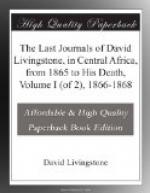Pottery seems to have been known to the Africans from the remotest times, for fragments are found everywhere, even among the oldest fossil bones in the country. Their pots for cooking, holding water and beer, are made by the women, and the form is preserved by the eye alone, for no sort of machine is ever used. A foundation or bottom is first laid, and a piece of bone or bamboo used to scrape the clay or to smooth over the pieces which are added to increase the roundness; the vessel is then left a night: the next morning a piece is added to the rim—as the air is dry several rounds may be added—and all is then carefully smoothed off; afterwards it is thoroughly sun-dried. A light fire of dried cow-dung, or corn-stalks, or straw, and grass with twigs, is made in a hole in the ground for the final baking. Ornaments are made on these pots of black lead, or before being hardened by the sun they are ornamented for a couple or three inches near the rim, all the tracery being in imitation of plaited basket work.
Chirikaloma says that the surname of the Makoa, to whom he belongs, is Mirazi—others have the surname Melola or Malola—Chimposola. All had the half-moon mark when in the south-east, but now they leave it off a good deal and adopt the Waiyau marks, because of living in their country. They show no indications of being named after beasts and birds. Mirazi was an ancestor; they eat all clean animals, but refuse the hyaena, leopard, or any beast that devours dead men.[13]
25th June, 1866.—On leaving Chirikaloma we came on to Namalo, whose village that morning had been deserted, the people moving off in a body towards the Matambwe country, where food is more abundant. A poor little girl was left in one of the huts from being too weak to walk, probably an orphan. The Arab slave-traders flee from the path as soon as they hear of our approach. The Rovuma is from 56 to 80 yards wide here. No food to be had for either love or money.
Near many of the villages we observe a wand bent and both ends inserted into the ground: a lot of medicine, usually the bark of trees, is buried beneath it. When sickness is in a village, the men proceed to the spot, wash themselves with the medicine and water, creep through beneath the bough, then bury the medicine and the evil influence together. This is also used to keep off evil spirits, wild beasts, and enemies.
Chirikaloma told us of a child in his tribe which was deformed from his birth. He had an abortive toe where his knee should have been; some said to his mother, “Kill him;” but she replied, “How can I kill my son?” He grew up and had many fine sons and daughters, but none deformed like himself: this was told in connection with an answer to my question about the treatment of Albinoes: he said they did not kill them, but they never grew to manhood. On inquiring if he had ever heard of cannibals, or people with tails, he replied, “Yes, but we have always understood that these and other monstrosities are met with only among you sea-going people.” The other monstrosities he referred to were those who are said to have eyes behind the head as well as in front: I have heard of them before, but then I was near Angola, in the west.




